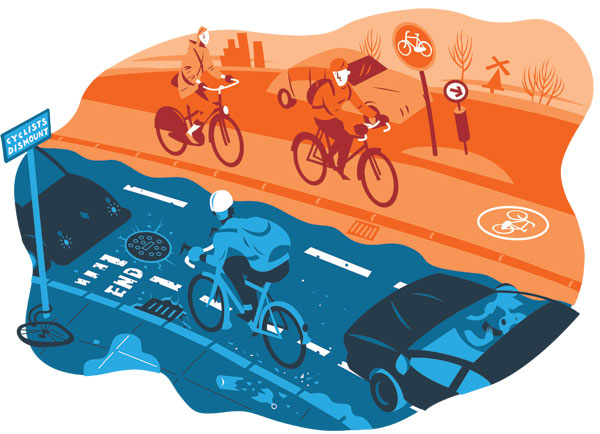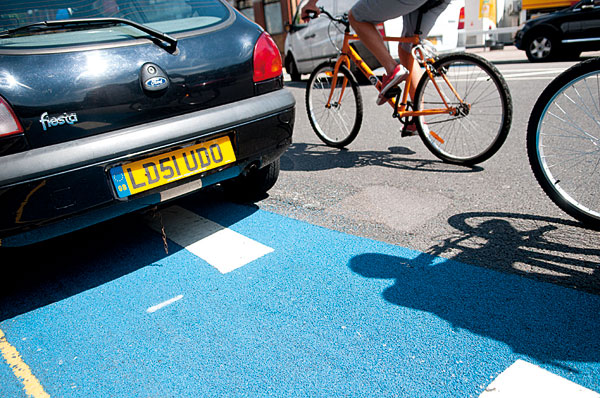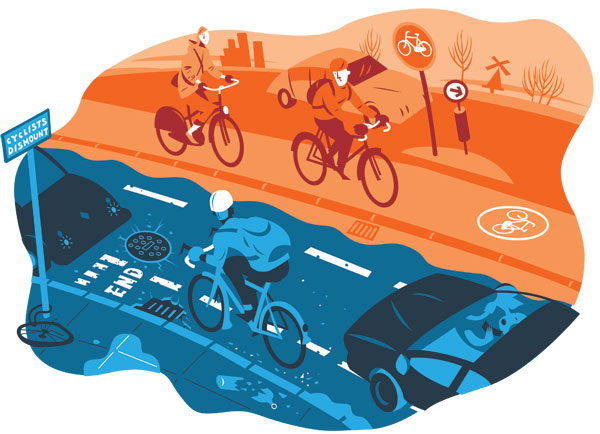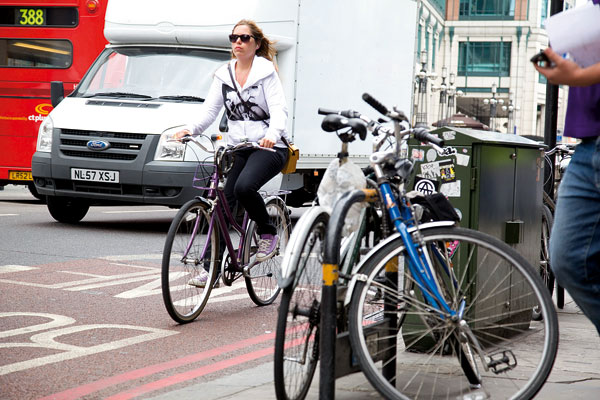How Britain has failed cycling

We've been fooled. In the 40 years I have reported on the tortuous business of cycle campaigning, no British town - with perhaps the exception of the London Cycle Network, and that's mostly on back streets - has yet managed to build a half-decent cycle network worthy of the name.
Over this same period the Dutch have revolutionised cycling, reversing a decline in the 1960s with a nationwide strategy that has resulted in 28 per cent of trips being made by bike today, compared to less than two per cent in Britain. But Britain has shunned Dutch expertise.
The Dutch authorities spend between £10 and £20 per head of population on cycling. Less than £1 per head of population is spent on cycling in England, with only the Cycling Demonstration Towns and London bucking the trend.
So much for all the government talk about backing cycling to make the nation fitter, addressing the serious obesity problem and reducing congestion.
"There are none!" Roger Geffen, campaigns and policy director of the CTC, the national cyclists' organisation, told me when I asked him to name six towns which have built cycle networks linking places people need to go.
It was my hope he would reveal the first stirrings of the creation of a cycle network along the lines of the quality networks they have in Holland or Scandinavia. How naive could I be?
Geffen told me he is not aware of any one town where they are getting it right. Bits and pieces are OK, but that's it, he said.
Get The Leadout Newsletter
The latest race content, interviews, features, reviews and expert buying guides, direct to your inbox!
The London-wide network, several hundred kilometres in the making and a work in progress for nigh on 30 years, struggled for a long time to get decent funding.
It has painstakingly been developed with cross-borough cooperation under the auspices of the London Cycling Campaign. But as it's mostly on back roads, the main roads still form a barrier in places.
Transport for London's Superhighways are meant to address this.
They are a step in right direction. But don't let all the PR hyperbole about them lure you into a false sense of security. "Super"! Not really; there are no traffic lights with cycling phases at any of the major junctions.
Could do better
"London is at least putting significant investment into cycling," says Geffen.
He describes their bike hire scheme as "phenomenally successful".
"Its pro-cycling advertising campaigns are models of best practice, and it does pretty well on other promotional activities too, such as cycle maps and cycle training. TfL is now also beginning to take the issue of lorry safety very seriously - and not before time."
He says, however, there are still some serious political constraints which will need to be overcome if London is to make the fundamental transformation into
a genuinely cycle-friendly city.
Geffen picked out other cities doing good things: "Leicester, Cambridge, Edinburgh, Bristol and Sheffield are all cities which are making serious efforts to boost cycle use, and are beginning to show positive results.
"Cambridge of course is way ahead in terms of actual levels of cycle use, thanks to a long tradition of cycling there, together with a network of narrow streets and historic buildings which meant it never opened itself up to mass car use in the 1960s.
"Yet Cambridge is still a long way short of the levels of cycle use in comparable Dutch cities, [such as Groningen]. As for the others, they have even bigger challenges.
"In short, even in Britain 's most pro-cycling cities, we still have a long way to go."

Fear of traffic
Although more and more people are taking up leisure cycling in the UK, the numbers commuting instead of using the car or other modes has hardly changed in 10 years, according to national statistics. And won't unless the roads are made safer.
In 2010, only 1.5 per cent of all trips were made by bike... bad winter weather responsible for a slight drop on 2009.
And of this 1.5 per cent, three or four per cent represent commuter or utility trips made by bike.
Not much different since 2001. Yes, London has seen big increases, but the capital is bucking the trend as people seek to avoid paying stupendously high public transport fares.
The problem, says CTC, is that putting in decent cycle lanes is seen as expensive at £800,000 per kilometre. The money available doesn't come close.
"There are cheaper options," says Chris Peck of the CTC. "For instance, speed reduction of traffic, traffic management, reduction in parking" - a highly controversial measure.
"Even so, cycling is growing, trade is booming, and the attitude towards cyclists has improved in the last few years," he adds.
Big project-itis
But Peck agrees there is no getting away from the fact that the overall standard of build of cycle facilities falls well short.
It is a fact that the pre-war cycle lanes of the 1930s and 1940s are often better than those built today, and even these early lanes had their faults, such as no right of way at junctions. It's the same today.
He says one of the big problems has been, and still is, the lack of political will.
I recall Philip Darnton, chair of the excellent Cycling England - the government body staffed by cycling experts that was killed off in the cuts this year - telling me he had encountered "institutionalised discrimination" against cyclists in his dealings with local authorities.
I recall transport minister Steven Norris was very fond of saying that MPs suffer from "big project-itis", as he called it. In other words, cycling issues were seen as too small to be associated with, compared to dreaming up, say, headline projects like a satellite system to monitor your car's mileage, or a new rail route.
And because cycling was seen as too small, the funding to make every town cycling friendly, though less than one per cent of the multi-billion pound transport budget and very good value indeed, was seen as too expensive.
I can think of only one of the many transport ministers I have interviewed - and all of them spoke eloquently of how important it was to create the right conditions for cycling - who ever personally got involved. This is Lord Adonis, who saw to it that Network Rail put cycle parking hubs in a few major stations. Even so, 300 parking spaces at, say, London Waterloo and Leeds, pales into insignificance alongside the 14,000 bike spaces provided at Utrecht station in Holland - and this is to be increased to 20,000 for a small town a fraction the size of London.
The idea that a cycling strategy properly applied could help deliver the balanced and sustainable transport MPs witter on about has been lost in the fog of government.
When over a decade ago John Prescott proposed radical changes to introduce a sustainable transport policy it upset the motoring lobby so much that he was moved off transport and his proposals binned.
Chris Peck says that transport minister Norman Baker, like Adonis, is a good guy, doing his best amid a raft of financial constraints.
So, it seems fairly certain that the persistent low level of utility trips made by bike can be put down to a combination of fear of traffic and a lack of decent comprehensive cycle networks in the towns.

Fools at the helm
What has brought us to this place? Could it be that transport decisions are made by people still hard-wired to the post-war image of the bike as working class, only to be begrudgingly accommodated with crap facilities as befits its station? Is it written in the Department for Transport Old Testament of the 1960s, when cyclists and pedestrians were designed out of road schemes, "Thou shall not provide for cyclists"?
Former transport minister and petrolhead Philip Hammond joined the ranks of the stupid when he recently suggested raising the motorway speed limit to 80mph. He must know that will influence drivers to push it that bit faster off the motorway, too.
I mean, what's all that about? I have it on good authority that Hammond did a deal with the Lib Dems. He'd lower the limit to 20mph on residential roads if they wouldn't oppose him increasing motorway limit to 80 - to placate the motoring lobby!
And we wonder why so many people are still deterred from cycling. The recent - zillionth - cycling report on the matter, by a Prof Colin Pooley, attempts to answer this question yet again. He made quite a stir by suggesting planners ignore established cyclists when seeking views! It was this report which prompted me to review the issues.
Apparently, the report should have said, don't only talk to enthusiasts.
But the report was clear: the main reason deterring a great many people from cycling is fear of traffic. So, nothing new there. The report calls for segregated cycle lanes, which will be far more difficult to deliver given that the authorities have made a pig's ear of far simpler facilities.
Sadly, on the evidence of the great many other reports the government has paid only lip service to the prof and his fellow academics, who might as well be pissing in the wind. What we need is a report that examines why, in 40 years, government transport specialists - local and central and every single one of the host of transport secretaries of state - have managed to fail cycling so miserably.
Their legacy: on-pavement cycle lanes with lamp posts blocking them; telephone boxes, bus shelters, even trees in them!
As for cycle lanes on the roads, where they ought to be - with few notable exceptions - they end abruptly, or run into parking bays, and generally don't go anywhere useful.
Some 20 years ago, the Dutch, in the English version of their wonderful Bicycle Master Plan, wrote in the foreword: "First of all let it be said that the Dutch don't have a problem with bicycles."
It was a clear jibe, for the Dutch clearly knew that the Brits do have a problem with bicycles.
Whereas the Dutch would rip out junctions and build from scratch to incorporate cycling facilities, in Britain we get crap add-on facilities if we're lucky.
The recent demonstrations over lack of planning for cyclists and walkers in the new road layout planned for Blackfriars Bridge in London is proof that prejudice is alive and well among those dinosaurs, the transport engineers.
Knee-jerk prejudice
It seems to me that this problem is deeply rooted in the British psyche, and this is the major reason why it has proven to be so difficult to establish rights for cyclists.
It ought to be quite simple.
Cut out frantic driving, cut the speed of traffic and we won't need any special cycling facilities!
OK, that's never going to happen, not with the mentality of most drivers who consider the road their own.
We need cycle lanes down every major road in towns and cities, not the few sprinkled here and there, which end suddenly. London Cycling Campaign are to call for this in their ‘Go Dutch' campaign in 2012.
But as things stand, advance stop zones are often as good as it gets, but even these often have no cycling lane leading into them.
This lack of recognition of cyclists' rights led John Grimshaw MBE, a civil engineer, to form Sustrans (Sustainable Transport) and start building traffic-free paths for cycling and walking on disused railway lines.
He'd hoped that his 1,000-mile plus National Cycle Network, now well established across the country, would be a catalyst for the creation of quality cycle networks within the towns the NCN passed through.
Surrey, he told me, proved to be one of the most difficult authorities to reach agreement with. Even now, the NCN 22 through Headley near Box Hill includes a blind junction exposing cyclists to fast-moving traffic.
Britain has proved incapable of rising to the challenge.
The other network of merit is the National Byway, a signed route along quiet country lanes which when finished will be some 3,000 miles long, linking sites of historical interest.

Cycling England's demise
If we take a look back over the past 15 years we can see how cycling policy has endured fits and starts.
The creation of the government body Cycling England in 2005, chaired by Philip Darnton, the ex Raleigh chief, and with the impressively forthright Grimshaw, gave us hope.
But it was poorly funded. Nevertheless, Cycling England launched its ‘Cycling Development Towns', which encouraged small projects and generated impressive increases in cycling use.
This was the proof of the pudding, but government failed to seize the initiative and substantially increase the budget. Instead, transport minister Ruth Kelly served up £140m over three years. Although the most generous funding yet, it was still about a third less than the Dutch, who are currently investing €100m in new cycle highways over the next two years. And then of course, Cycling England fell victim to government cuts and the bonfire of the quangos.
And yet cycling is booming in recession-hit UK. According to a British Cycling and Sky-commissioned report, it's worth £3bn a year to the UK economy.
The pastime has never had it so good, with city-centre mass rides on closed roads attracting upwards of 60,000 people of all ages - but they have to brave hostile roads to get there - and charity rides aplenty.
As for the sport, the huge success of the track riders at the 2008 Beijing Olympics was followed this year with Britain topping the medal table at the road World Championships in Copenhagen - crowned by Mark Cavendish's historic victory in the elite road race.
Yet, despite all of this, despite an impressive increase in cycling use in London - up 91 per cent in 2007, compared with 2000 - cycle use remains low compared to rest of the Europe.
London proudly declared that 500,000 journeys a day are made by bike in the capital, yet it is still only two per cent of all journeys. Amsterdam racks up 37 per cent; Groningen a massive 57 per cent.
What is it with the British government? With civil servants? What is it that they just don't get? When we look back even further, to the mid-1990s, we recall how the CTC declared the battle for minds won. The government at last agreed to take account of cyclists' needs, to encourage people to take up cycling, to save the nation's health, to cut congestion and therefore pollution. Campaigners thought that at last, cycling was to have its day. But no.
Strategic error
It never happened, not even when the National Cycling Strategy was created under the Conservatives in 1996, and launched with a huge press conference in London. This was the first ever transport strategy, a historic moment.
A breakthrough, at last. But there was a catch. There was no money for it!
I recall transport journalist Christian Wolmar demanding Sir George Young, the secretary of state for transport, to tell us where the money was.
"Well, where is it?" said Wolmar.
"Where's what?" replied Sir George, a lifelong cyclist, by the way.
"The money, there's no money," countered Wolmar.
Sir George told us it didn't need any money as such, because transport planners would be required to include cycling within the budget already provided for general transport development.
It never happened, not on a realistic scale.
In fact, when, to induce local authorities to apply for grants to build ‘integrated' transport facilities, such as for cycling, many of the local authorities siphoned the money off into ordinary road building schemes.
The government raised hopes yet again by endorsing a brilliant design guide, setting out how to build a cycling infrastructure into the road system. Turns out this is as close as it would get to emulating the best of what we see abroad.
So what happened next? Nothing. Local transport engineers took no notice of the guidelines.
And because the Department for Transport's jurisdiction extends only to trunk routes, they have no say what happens with over 90 per cent of the rest of the road infrastructure which remains the legal responsibility of each local authority. Government can only advise and recommend, but not even they can tell local authorities what to do with their own roads.
How the Dutch got it right
Ironically, Holland was once governed in much the same way. But I learned they changed the law to give government control over local authorities to implement the cycling infrastructure which ever since has been the benchmark.
The wonderful design guide, when made available to the local authorities, went onto the shelf, never to be seen again.
When the CTC and other campaigners realised they had ridden up a blind alley, they had to start all over again, and work on local mandarins to heed government advice on cycling.
Now, some were easier to persuade than others and they had a genuine interest in making the roads safer for cycling. But they have been thwarted by bureaucracy, lack of joined-up thinking between transport, health and education, and by bloody-mindedness. By institutionalised discrimination against cycling.
Years went by before a greater enlightenment spread to the local authorities. Then came another twist in the story. For the cycling movement had reckoned without each area's transport chiefs, a breed of dingbat largely against giving up any part of their highway for bikes! Still are in most areas.
Local transport chiefs prefer not to follow official guidelines on how to build cycling infrastructure, saying they know best. Result: an ad hoc load of mostly substandard facilities, which in some areas present more of a danger to cyclists than he or she faces on the road.
Remember the Kyoto Protocol of 1997, formed under the United Nations Framework Convention on Climate Control?
This spawned the idea that much could be achieved at local level by local people getting involved, with ideas on how to reduce pollution.
Cycling and walking groups were among those created.
The local authorities said they welcomed their input, and would encourage them. But if my excellent local group is a typical example, their suggestions are ignored and like, hamsters in a wheel, they are going round and round in bureaucratic circles, getting nowhere fast.
No idea
I've met councillors, MPs, who believe they are doing what's right for cycling.
I recall a local councillor, nice bloke, declaring how proud he was of what his council had achieved - cycle lanes on pavements with lamp posts stuck in them, and horribly surfaced.
Most cycling networks are pinched, narrow, squeezed into the existing road infrastructure, unlike those in Holland, where at the design stage of a major road junction they will ask, "How will the cyclist and moped rider cope?" In Holland they have ripped out junctions and built from scratch to put cycling facilities in place.
Infuriatingly, much of the UK's hopeless cycle lanes have ended up where they were never intended to be, on the pavements, as so-called shared paths, as local authorities have done what comes easiest to them.
Today, the much-admired Danish and Dutch models remain an elusive dream.
Will the UK ever develop anything remotely similar?
No chance. Others may hold hope but, in my view, this is as good as it gets.
Related links
London Assembly backs cycle safety proposals
Father of dead cyclist calls London Assembly 'disgraceful'
Pressure on London mayor after 16th cyclist killed in capital this year
Reduce road speed to increase cycle safety, finds government report
Ghost bike for Deep Lee

Thank you for reading 20 articles this month* Join now for unlimited access
Enjoy your first month for just £1 / $1 / €1
*Read 5 free articles per month without a subscription

Join now for unlimited access
Try first month for just £1 / $1 / €1
Founded in 1891, Cycling Weekly and its team of expert journalists brings cyclists in-depth reviews, extensive coverage of both professional and domestic racing, as well as fitness advice and 'brew a cuppa and put your feet up' features. Cycling Weekly serves its audience across a range of platforms, from good old-fashioned print to online journalism, and video.
-
 Mike's Bikes 'mega sale' is live and site wide with discounts over 50%
Mike's Bikes 'mega sale' is live and site wide with discounts over 50%Running until Sunday all products are discounted including complete bikes, clothing, smart trainers and much more
By Luke Friend
-
 Can you be a pro athlete and an environmentalist? Earth Day reflections from a pro cyclist trying to be both
Can you be a pro athlete and an environmentalist? Earth Day reflections from a pro cyclist trying to be bothHow Sarah Sturm reconciles her life as a pro cyclist with her environmental values
By Sarah Sturm